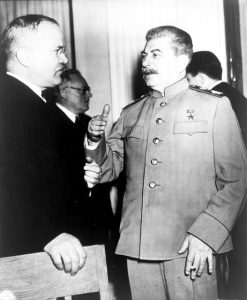The Yalta Conference: The Great Meeting
As World War II was heading to its end, the Allied leaders, Stalin, Roosevelt and Churchill met at Yalta in the second of three meetings of the so-called “Big Three”. The Yalta conference had the code name, the Argonaut Conference, and is also sometimes called the Crimea Conference, because it was held at a crimean port on the Black Sea. During the Yalta conference, the leaders discussed what was to happen during the final stages of WW2 and how to regulate a post-war Europe. The agreements made during the Yalta conference were kept secret initially, but became quite controversial later, especially during the Cold War.

Yalta Conference – Some Key Agreements:
- The three leaders agreed that Germany was to surrender unconditionally
- Germany and Berlin were to be split up in four occupational zones
- Division of other territories were discussed and agreed upon
- Stalin agreed to allow free elections in Eastern Europe
- Stalin also promised to get involved in the war against Japan, on the condition that he gets the lands back that were conquered by Japan during the 1904-05 Russo-Japanese War.
- Stalin wanted 16 Soviet Socialist Republics to be allowed to join the United Nations, but 14 of them were denied.
- The leaders agreed that a “Committee on Dismemberment of Germany” had to be established.
This article is part of our larger educational resource on World War Two. For a comprehensive list of World War 2 facts, including the primary actors in the war, causes, a comprehensive timeline, and bibliography, click here.
Cite This Article
"Yalta Conference – What Exactly Was It and Who Was There?" History on the Net© 2000-2024, Salem Media.
July 27, 2024 <https://www.historyonthenet.com/define-yalta-conference>
More Citation Information.





